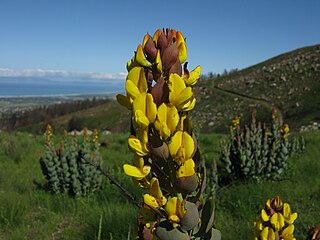
Psoralea is a genus in the legume family (Fabaceae) with 111 species of shrubs, trees, and herbs native to southern and eastern Africa, ranging from Kenya to South Africa. In South Africa they are commonly referred to as fountainbush (English); fonteinbos, bloukeur, or penwortel (Afrikaans); and umHlonishwa (Zulu).

Lotononis is a genus of flowering plants in the family Fabaceae and the tribe Crotalarieae. The genus includes 99 species of annual and perennial herbs, native to the southeastern Europe and Turkey, eastern Africa, and southern Africa.

Phylica is a genus of plants in the family Rhamnaceae. It contains about 150 species, the majority of which are restricted to South Africa, where they form part of the fynbos. A few species occur in other parts of southern Africa, and on islands including Madagascar, the Mascarene Islands, Île Amsterdam, Saint Helena, Tristan da Cunha, and Gough Island. Phylica piloburmensis from the Burmese amber of Myanmar, dating to around 99 million years ago during the mid-Cretaceous, was originally described as the oldest fossil member of the genus, but subsequent studies contested its assignment to the genus Phylica.

Amphithalea is a genus of flowering plants in the family Fabaceae. It belongs to the subfamily Faboideae. It includes 41 species endemic to the Cape Provinces of South Africa.

Aspalathus is a genus of flowering plants in the family Fabaceae. The yellow flowers and spiny habit of some species have suggested a resemblance to Ulex europaeus, the thorny "English gorse" Accordingly, "Cape Gorse" has been proposed as a common name although the resemblance is largely superficial; for instance, gorse is thorny, whereas Aspalathus species are variously spiny or unarmed. The genus belongs to the subfamily Faboideae. There are over 270 species, mainly endemic to southwestern fynbos regions in South Africa, with over fifty occurring on the Cape Peninsula alone. The species Aspalathus linearis is commercially important, being farmed as the source of Rooibos tea.

Rafnia is a genus of flowering plants in the family Fabaceae. It includes 29 species of shrubs and subshrubs native to South Africa. They grow in Mediterranean-climate fynbos (shrubland) and grassland, mostly on rocky and sandy soils. Most are native to the Cape Provinces, with some extending eastwards into KwaZulu-Natal. It belongs to subfamily Faboideae.

Hermannia is a genus of flowering plants in the mallow family, Malvaceae. It comprises at least 65 species with many more species as yet unresolved.

Searsia is a genus of flowering plants in the family Anacardiaceae. It includes over 100 species native to Africa, the eastern Mediterranean, Arabian Peninsula, Indian subcontinent, Myanmar, and south-central China.
Acrosanthes is a genus of flowering plants in the family Aizoaceae. It is native to the Namibia and South Africa's Cape Provinces in Southern Africa.
Hermas is a genus of flowering plant in the family Apiaceae, native to Cape Provinces of South Africa.

Hibiscus pusillus is a species of flowering plant in the family Malvaceae, native to seasonally dry areas of southern Africa. There is some confusion with Hibiscus trionum, with which it shares the common names bladderweed and Terblansbossie (Afrikaans), perhaps due to the name Hibiscus pusillusEckl. & Zeyh. being a synonym of Hibiscus trionumL., sometimes called the bladder hibiscus.








